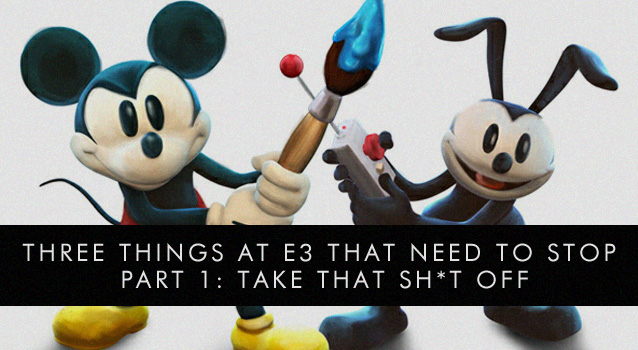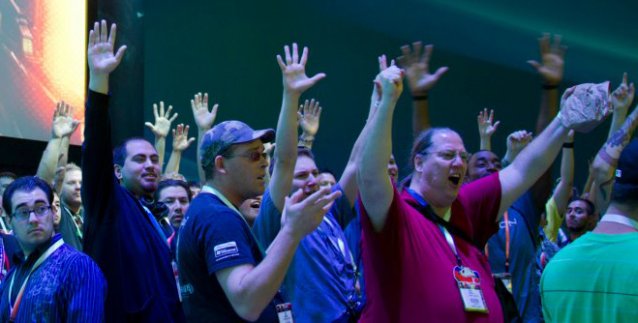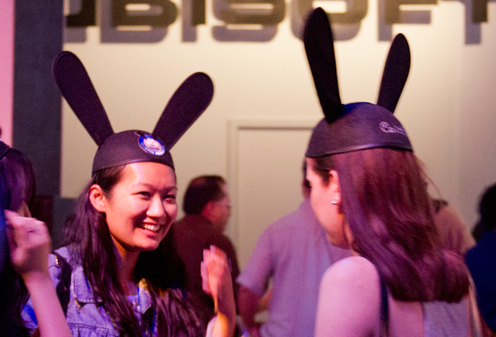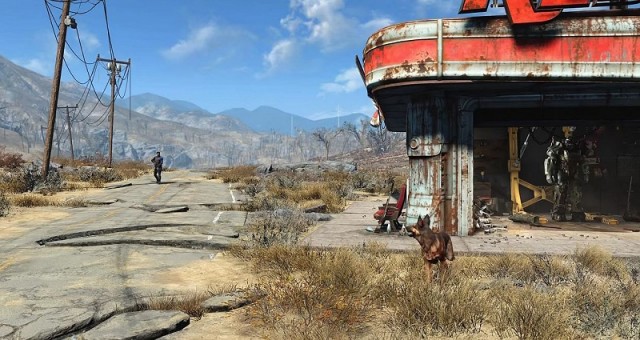


When I descended upon the not-so-hallowed halls of the Los Angeles Convention Center a couple weeks ago, I did so with the intent to get in, shake hands with some people, and get the hell out. E3 is not really my kind of thing, but the prospect of socializing with game journalists and critics, people with whom I'd worked and established fond professional friendships over the last two years, was too significant to pass up. So, bringing along my granola bars and a trusty photographer friend, we hit the show floor-- and as expected, it was every bit the technosexual military fetish orgy it had been when I visited last year.
But I'll get to that later.
I am, as you may've guessed by now, a bit of an outspoken critic of these things. And by 'things,' I mean the horrible electronics consumer culture and technofetishism that lies at the heart of big-industry gaming. Readers beware-- if you hold E3 up in your mind as some kind of gamer Carnivale, this series is not for you.
And speaking or the carnivalesque, that's the subject I want to address right off the bat: E3's ridiculous fairgrounds atmosphere, and its attendees' willful participation in it.
You know what I'm talking about. I'm talking about E3's show floor swag.

Look, hypothetical E3 attendee. You are a professional, or you should be, because I've been turned away from the show before as not professional enough, so presumably you've got your act together more than me, and I like to think the site I curate for is a pretty class act. So I'm assuming you are a legitimate enough working professional to convince the people at registration to hand you a badge. And enough to, say, not act like a kid excitedly darting toward the rides as soon as he's through the gates, wearing a Mass Effect hoodie and Portal t-shirt, Mario keychain hanging off your belt.
Now look, I own all of that aforementioned merchandise. And I expressly wore none of it while at the convention. Why? Because voluntary corporate branding is enough of a social disease without racing about the E3 show floor wearing Disney bunny ears.

Preview a feat of human engineering and walk away with a FREE one-inch plastic thing!
I'm not ignorant of the condition that is E3 swag frenzy. Some of these items become valuable one-of-a-kind collectibles that start showing up on eBay before the expo is even over. Which, once again, is a disgusting situation publishers and studios have no business fostering. This is supposed to be a trade conference, so why perpetuate the slavering fanboy image even further by tossing out t-shirts into a crowd and getting people to queue up who are more interested in the latest pin than the game you're trying to hawk?
It goes beyond swag, obviously. A mainstay this year were photo booths where a participant could get a free photo taken with Master Chief, or Master Chief's assault rifle, or two generic Enterprise bridge officers in miniskirts. Much mockery has been made of E3's booth babe marketing ploys and the opportunity to "get your picture taken with a real live girl!" but this really extends much further than sexual objectification and into the realm of selling your event on novelty and fandom alone. It's not Disneyland. And speaking of which...
Yes, those freaking rabbit ears.
 One of the biggest hits on the show floor this year was Disney's Epic Mickey 2 tie-in Oswald the Rabbit ears. It's somewhere between hilariously poignant and nauseating that a major conglomerate like the Walt Disney Corporation, which essentially gets into the game industry for the fun of it since it doesn't exactly rely on games to sustain its global media industry, could be so deviously effective at getting a bunch of presumed free-thinking adult professionals to join a long-eared version of the Mickey Mouse Club for three days. You couldn't pay people to be such effective walking advertisements for your product, and that's a problem when your global cultural influence already outstrips that of most nations.
One of the biggest hits on the show floor this year was Disney's Epic Mickey 2 tie-in Oswald the Rabbit ears. It's somewhere between hilariously poignant and nauseating that a major conglomerate like the Walt Disney Corporation, which essentially gets into the game industry for the fun of it since it doesn't exactly rely on games to sustain its global media industry, could be so deviously effective at getting a bunch of presumed free-thinking adult professionals to join a long-eared version of the Mickey Mouse Club for three days. You couldn't pay people to be such effective walking advertisements for your product, and that's a problem when your global cultural influence already outstrips that of most nations.
Why do we allow this? Setting aside that mainstream game development is a putridly risk-averse industry which actively suppresses creativity in favor of endless licenses and sequels, why do supposed journalists --those whose job it is to act as checks against the industry and maybe, maybe, critique its failings-- assent to dressing up in silly hats for corporate promotion like this? Don't we already subsist enough on paid advertising from publishers without lining up around a booth to advertise for them for free?
The worst part is that this has been going on so long, it's become an accepted part of the industry's perpetual publicity machine. With E3 press conferences televised and the spectacle of the event ramped up so much in excess of the actual products being revealed, stuff like this happens:
I didn't feel like a professional journalist at that event -- I felt like a partygoer at Carnival, sans the booze. I wanted to be there for the information, I would've liked to sit back and watch the crowd's reaction to the games, but I was too busy trying not to trip over Cirque du Soleil performers while jockeying for a better view of the stage where we thought there'd be games. Turned out USA Today already had a press release with each of the games listed and they wound up with more information than any of the reporters that actually attended the event. Oh, and the event was televised -- so technically, we journalists weren't even partygoers, we were stage props.
That's from journalist AJ Glasser's "No Cheering in the Press Box", a seminal 2010 metacritique of the state of game journalism. You should definitely read the editorial in its entirety, especially now that the good editors of PCWorld have courteously republished it for posterity. But the important takeaway here is Glasser's observation about how the expo distills its enthusiast press not just to enamored audience members, but decoration: a reliable soundtrack of approval, a neverending series of walking billboards, an army of Mouseketeers.
From Glasser again:
Video game press events are turning into a circus and that's bad news for the industry. Not only am I stuck waiting for my fellow journos to sit down and shut up so the next "act" can come on, but developers are getting warped feedback on their games from the one source in the world they should be able to trust -- the journalists. [...] My feelings on their product -- and on their performance, if they insist on pandering -- are either irrelevant or should only show up in my previews, reviews, or editorials; not in their demo rooms or their press conferences.
And they definitely aren't paying you to be a human advertisement. So for the love of AJ Glasser, take that shit off.
Even this, however, is just the beginning. The tip of an entire iceberg of fail, if you will. If we really want to address what's wrong with E3, we need to go beyond the activities of the individual participants on the show floor and address the overarching system that facilitates their behavior year after year. But that, dear reader, if you can stomach my Negative Nancy attitude again, I will keep for next week.
Photography credit: Jennifer Roy, 2012.




 Fallout 4: Dangerous Minds - Find Doctor Amari at Memory Den and Discover Goodneighbor
Fallout 4: Dangerous Minds - Find Doctor Amari at Memory Den and Discover Goodneighbor Where To Find The Witcher 3: Wild Hunt Extra Content On Steam? It's In Witcher 3 Directory, Exact Directory Path Revealed
Where To Find The Witcher 3: Wild Hunt Extra Content On Steam? It's In Witcher 3 Directory, Exact Directory Path Revealed Top 10 Players in FIFA 15: #7 - #5
Top 10 Players in FIFA 15: #7 - #5 Borderlands: The Pre-Sequel Wiki – Everything you need to know about the game .
Borderlands: The Pre-Sequel Wiki – Everything you need to know about the game . Just Cause 3 - How to Unlock Fast Travel
Just Cause 3 - How to Unlock Fast Travel